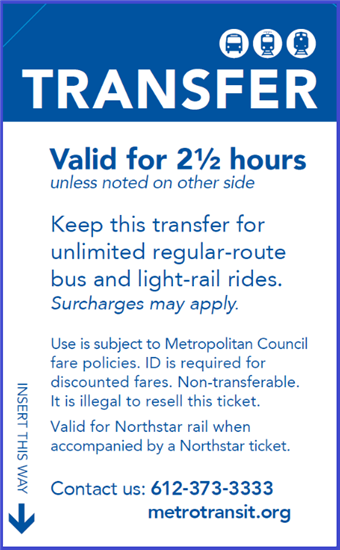This week’s Good Question comes from Andrew Balfour, who emailed to ask: “Why are transfers allowed?
Why not just have payment required for each trip and a lower per-trip cost instead?”

Metro Transit operates nearly 130 routes in 90 metro-area cities. Because one-seat rides can’t be efficiently delivered to all customers across this broad territory, buses run on a grid system that allows customers to easily combine routes to reach their final destination. Transit Centers where multiple routes converge serve as key transfer points in this system.
Transfers offer several distinct advantages to customers and transit providers.
For customers, using transfers to travel two or more routes is more cost-effective and simpler than paying separate fares at each boarding. For Metro Transit and other regional transit providers that use the same fare system, transfers simplify fare collection and speed boarding which adds up to more service hours.
Asking customers to pay for each trip would not only eliminate these advantages, but would lead to a more complicated route structure and less efficient service.
With a transfer, customers get unlimited rides at the same fare level, in any direction, within 2½ hours of the original fare. Roughly one-third of Metro Transit bus customers use transfers during their trips. In a 2012 customer survey, 40 percent of METRO Blue Line customers reported transferring to a bus before or after riding a train. The same survey found that 25 percent of Northstar customers transferred to light rail and that 21 percent transferred to a bus.
Combining routes and switching between buses and trains is especially easy for those with Go-To Cards, the most popular form of paying fares, or who use a Metropass or U-Pass. These "smart" fare cards automatically store transfers and can be used to conveniently pay the difference when transferring to a service with a higher fare, such as a Northstar commuter train or rush-hour express bus.
Customers who pay their fare in cash simply ask the driver for a paper transfer; paper tickets dispensed by rail ticket machines work in the same way. In the past, paper transfer slips were manually torn by operators in a “transfer cutter." Today, a magnetic stripe automatically records the expiration time and can be used when boarding another bus or as on the Blue Line, Red Line or Northstar.
Metro Transit’s use of transfers is not unique. Most U.S. transit agencies offer them. Those that don’t typically sell day passes that provide unlimited rides for up to 24 hours (Metro Transit offers passes that are good for unlimited rides in increments.
Free transfers were offered by Twin City Lines beginning in 1890, around the advent of the electric trolley network. The transfers were only free to a point, however. Customers traveling between Minneapolis and St. Paul faced a double fare and trips to the suburbs cost a dime or more extra. The transfers were good for an hour and could only be used to continue a trip in the same direction.
Return trips could not be made with a transfer until 1998, when the transfer window was extended to 2½ hours and the magnetic stripe fare collection equipment was implemented. The changes allow those customers with longer trips more time to reach their final destination. Customers making a round-trip also have a greater ability to return on the same fare.
Note: If a transfer expires while riding a Pay Exit bus, when fares are collected at the end of a trip, customers will be asked to pay the full fare. Transfers are not provided in Downtown Zones, where fares are 50¢ per ride.
>Transit Centers
Have a “Good Question” that you want answered? Email it to [email protected].